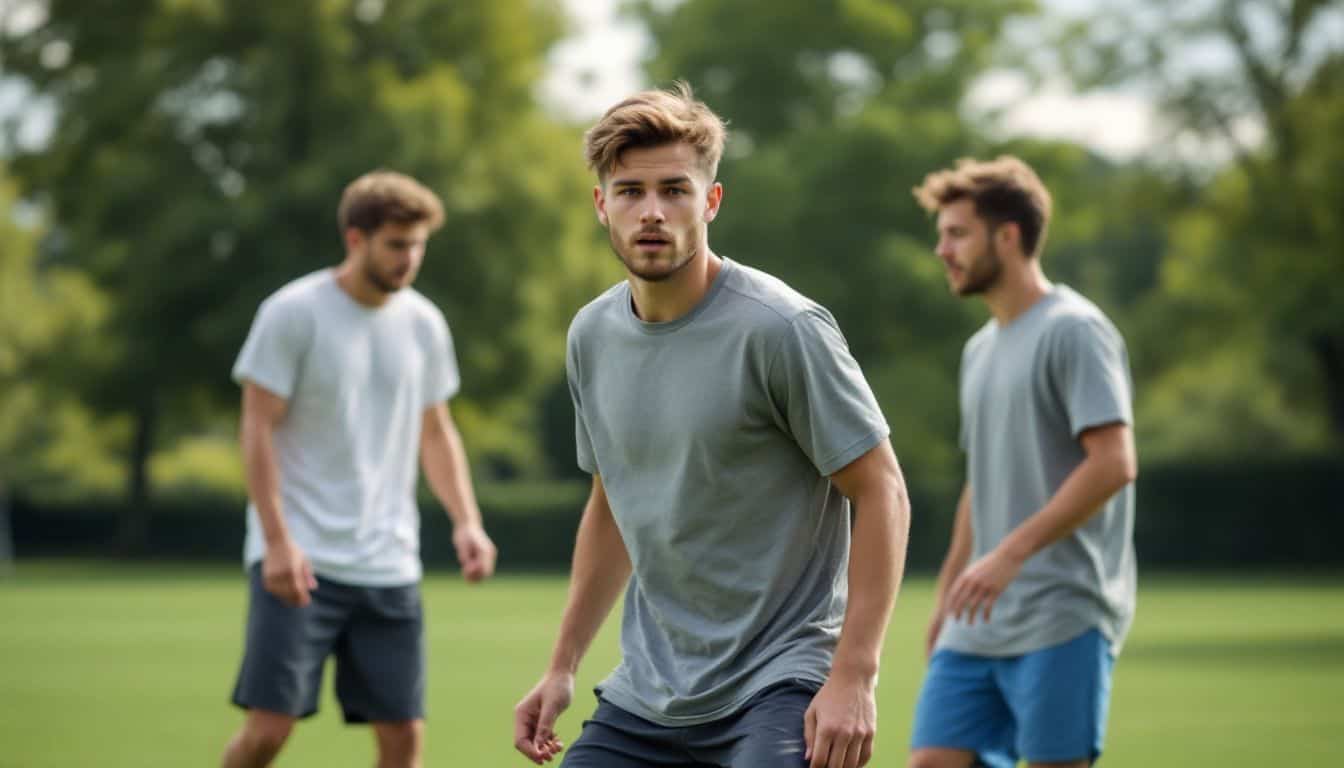Dreaming of becoming a soccer star but don’t know where to start? You’re not alone. Soccer is the world’s most popular sport, with over 4 billion fans globally. This article will give you 7 game-changing tips on how to learn to play soccer like a pro.
Get ready to kick your skills into high gear!
Key Takeaways
Master soccer basics like game structure, rules, and key skills such as dribbling, passing, and shooting to build a strong foundation.
Practice consistently for at least an hour daily to improve your skills and make playing feel more natural over time.
Watch professional soccer games to learn tactics and techniques from top players, paying attention to their movements on and off the ball.
Use online platforms, apps, and technology like MyPersonalFootballCoach.com or Dribble Up’s Smart Soccer Ball to enhance your training.
Join local soccer clubs, attend camps, and participate in leagues to get expert coaching, make friends, and gain real game experience.
Table of Contents
Soccer Basics

Soccer basics are the building blocks of the game. They cover the rules and structure that make soccer… well, soccer! Knowing these fundamentals will help you follow the action on the field and play better yourself.
Game structure

Soccer games have a simple structure. Two teams of 11 players each face off on a field. The game lasts 90 minutes, split into two 45-minute halves. During this time, players try to score goals by kicking the ball into the other team’s net.
A referee keeps things fair and follows the rules set by the International Football Association Board.
Teams need at least 7 players to start a match. This rule helps keep games going even if some players can’t make it. The sport many call European football is all about teamwork, skill, and strategy.
Next, let’s look at some key rules that shape how the game is played.
Key rules of soccer
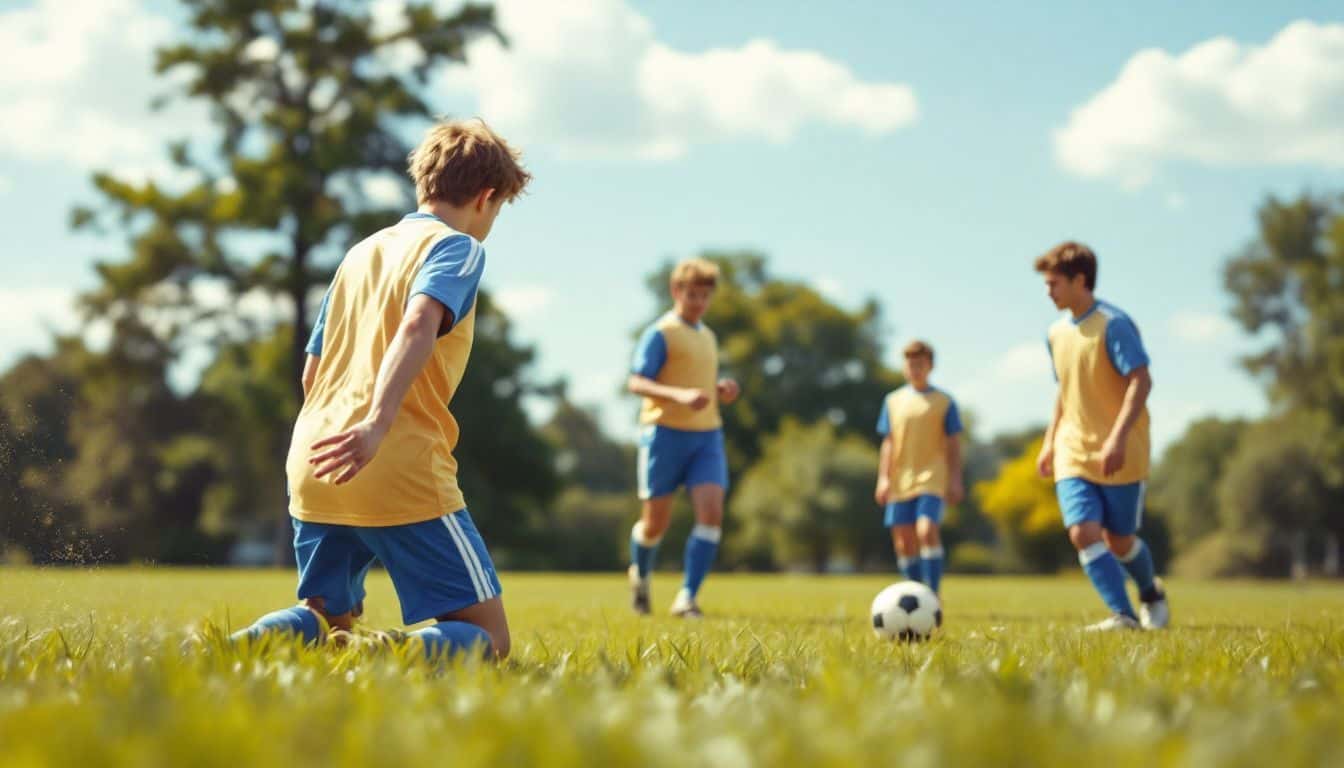
Soccer has some key rules you need to know. First, you can’t use your hands – unless you’re the goalkeeper. The ball must stay in play, and if it goes out, the other team gets it. Goals happen when the ball crosses the goal line fully.
It’s that simple!
Fouls are a big deal in soccer. If you commit one, the other team gets a free kick. Sometimes, it’s a direct shot at goal. Other times, it’s indirect – meaning another player must touch it first.
Serious fouls can earn you a yellow card (a warning) or a red card (you’re out!). Oh, and don’t forget the tricky offside rule. It keeps forwards from camping near the goal.
Soccer is simple, but it is difficult to play simple. – Johan Cruyff
Key Soccer Skills to Develop
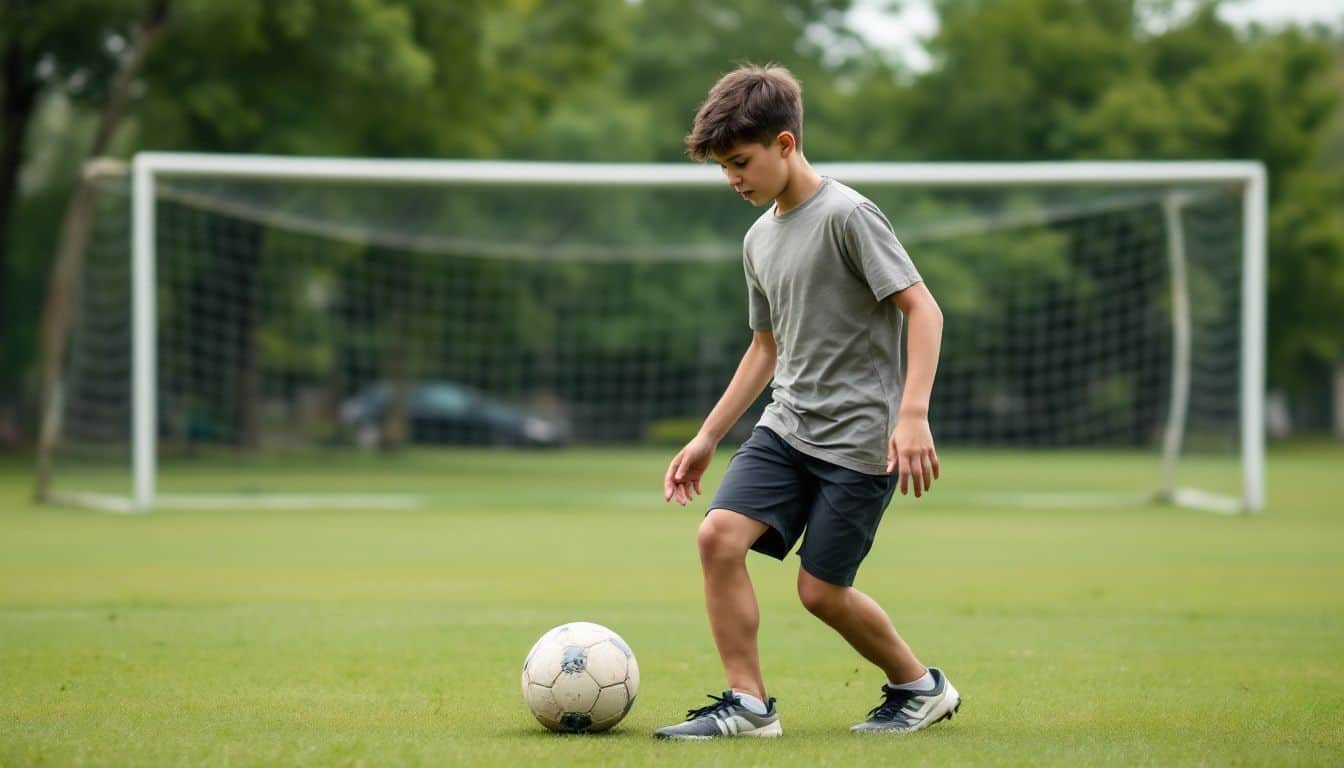
Ready to kick your soccer game up a notch? Let’s dive into the key skills that’ll make you shine on the field. From fancy footwork to killer shots, we’ve got the scoop on what’ll turn you into a soccer superstar.
Techniques for dribbling
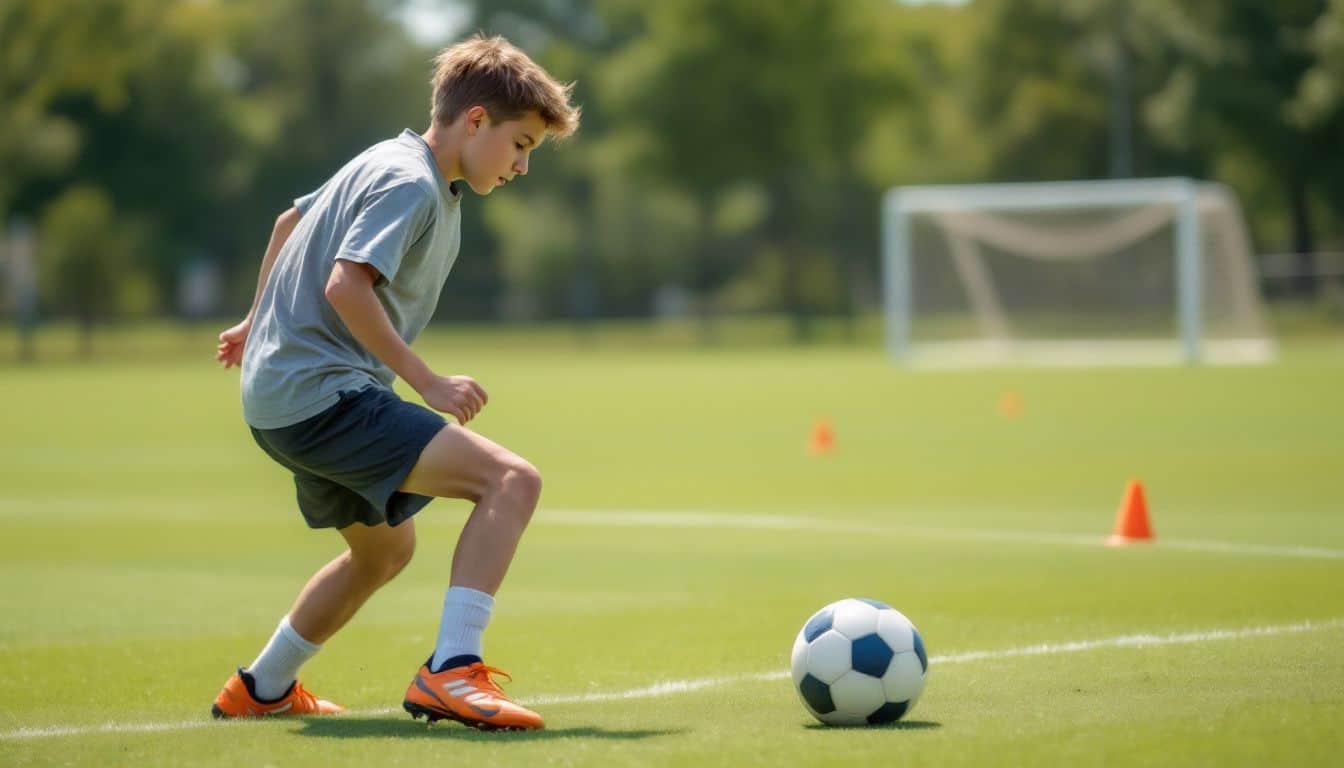
Dribbling is a key skill in soccer that can make or break your game. Let’s dive into some techniques that’ll help you become a dribbling pro.
- Master close control: Keep the ball within arm’s reach. Use small, quick touches to move the ball with different parts of your foot – inside, outside, and sole.
- Change direction often: Throw off defenders by suddenly switching your path. Practice quick turns, cuts, and feints to keep opponents guessing.
- Vary your speed: Mix up slow and fast movements. Slow down to draw defenders in, then burst past them with a sudden burst of speed.
- Use your body: Shield the ball with your body. Lean slightly over the ball to protect it from tackles.
- Practice cone drills: Set up cones and weave through them. This helps improve your control and agility with the ball at your feet.
- Try 1v1 drills: Face off against a partner. This mimics real game situations and boosts your confidence in taking on defenders.
- Play small-sided games: Join 3v3 or 4v4 matches. These give you more touches on the ball and force you to dribble in tight spaces.
- Work on your stance: Keep your knees slightly bent and feet shoulder-width apart. Lean a bit forward to stay balanced and ready to move.
How to improve passing accuracy
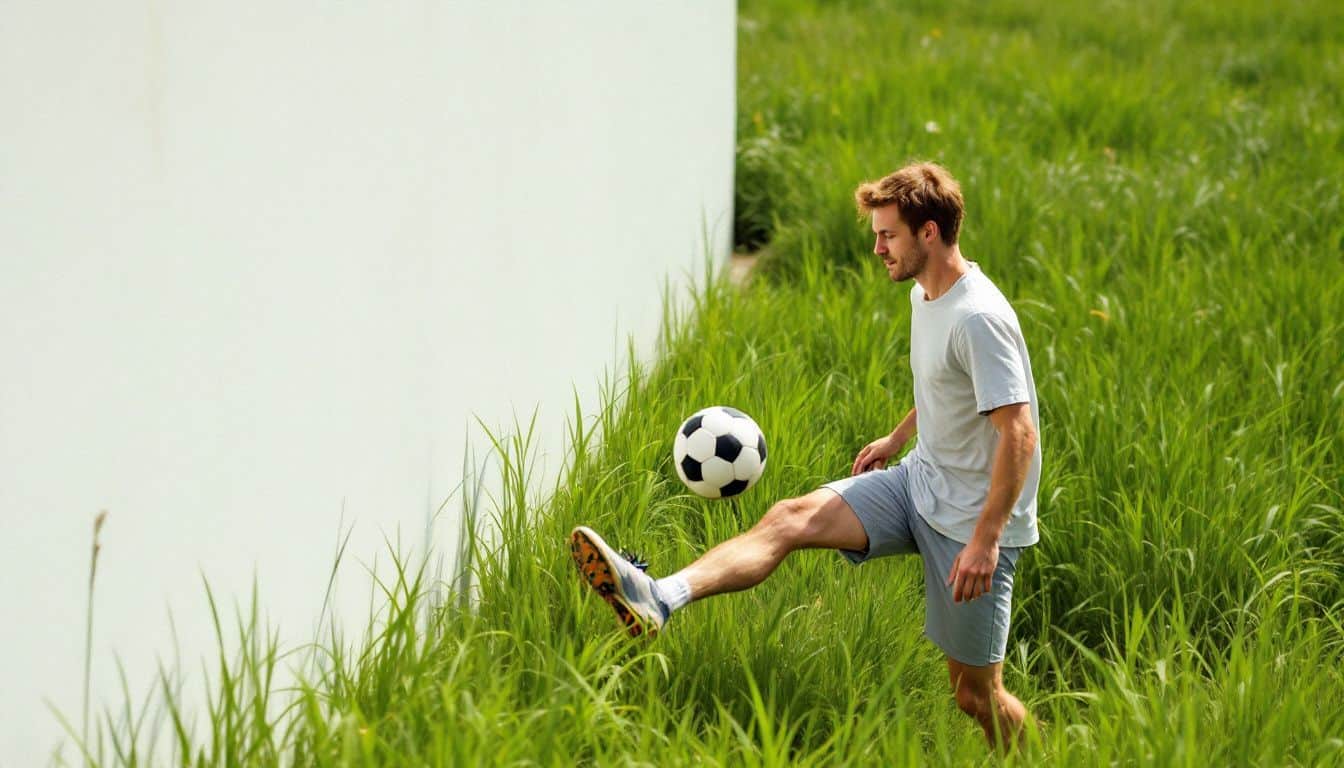
Passing accuracy is crucial in soccer. Let’s explore some game-changing tips to boost your passing skills.
- Practice with both feet: Kick the ball with your left and right foot equally. This opens up more passing options and keeps defenders guessing.
- Pass often during games: The more you pass, the better you’ll get. Regular passing sharpens your field vision and overall skill.
- Focus on quick, short passes: Fast, short passes are easier to control. They keep the game flowing and improve your accuracy over time.
- Create space before receiving: Move away from defenders before getting the ball. This gives you more time to make smart passing choices.
- Work on your first touch: A good first touch sets up better passes. Spend time practicing how you receive the ball to improve your passing.
- Use proper technique: Keep your eye on the ball and follow through with your kick. Good form leads to more accurate passes.
- Try different types of passes: Mix it up with ground passes, lobs, and through balls. Variety in your passing game makes you unpredictable.
- Play wall passes in practice: Use a wall to practice rapid-fire passing. This builds muscle memory and improves your touch on the ball.
Now, let’s move on to enhancing your shooting skills to round out your offensive game.
Enhancing shooting skills
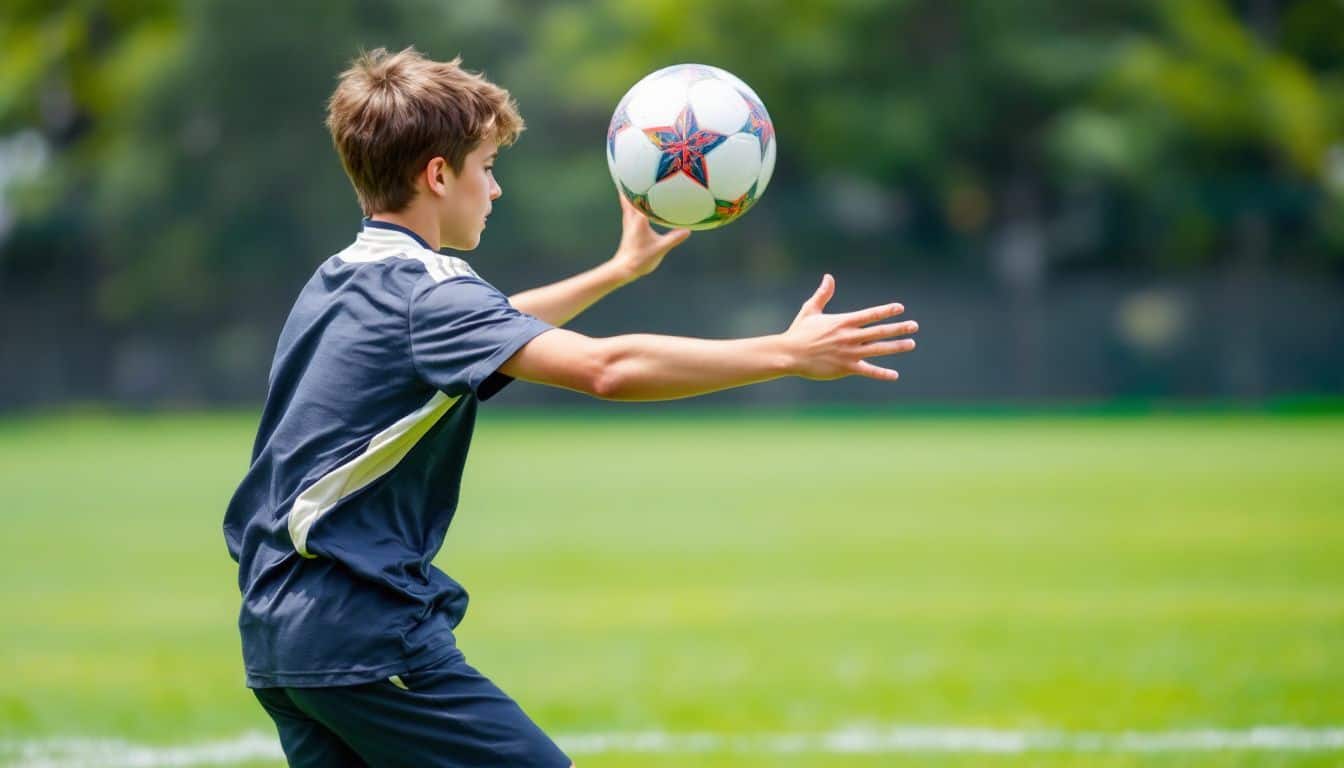
Shooting skills are crucial for any soccer player. Let’s dive into some game-changing tips to boost your shooting prowess.
- Practice proper form: Keep your eyes on the ball, plant your non-kicking foot next to it, and strike with the laces of your shoe. This technique helps you hit the ball with power and accuracy.
- Aim for the corners: Goalkeepers struggle to reach shots aimed at the top or bottom corners of the goal. Focus on hitting these spots during practice to increase your scoring chances.
- Use both feet: Don’t rely solely on your dominant leg. Train your weaker foot too. A study showed that after an 8-week Balance Training Program, players improved their dominant leg shooting accuracy by 83.84%.
- Work on your balance: Good balance is key for accurate shots. Try standing on one leg while doing everyday tasks to improve your stability.
- Practice different types of shots: Mix it up with volleys, chip shots, and curled shots. Each type has its use in different game situations.
- Shoot under pressure: Have a friend act as a defender during practice. This simulates real game conditions and helps you stay calm when shooting.
- Get private soccer training: One-on-one coaching can help you focus on your specific shooting weaknesses and improve faster. I decided to get private soccer training near me to refine my technique and boost my confidence on the field.
- Use visual cues: Pick a spot on the goal before shooting. This mental trick can improve your accuracy and confidence.
- Build leg strength: Strong legs mean powerful shots. Include squats and lunges in your workout routine to boost your shooting power.
- Watch and learn: Study pro players’ shooting techniques. Pay attention to their body positioning and follow-through when they score goals.
Soccer Training Techniques

Ready to up your soccer game? Let’s kick things off with some killer training techniques. These drills and practices will have you dribbling, passing, and scoring like a pro in no time!
Drills to enhance skills
Soccer drills can boost your game big time. Let’s dive into some cool exercises that’ll help you level up your skills:
- Cone Dribble: Set up cones in a zigzag pattern. Weave through them with the ball at your feet. This drill sharpens your ball control and footwork.
- One-on-One: Pair up with a buddy. Take turns being the attacker and defender. It’s great for improving your tackling and dribbling under pressure.
- Basic Square Passing: Form a square with three friends. Pass the ball around the square, focusing on accuracy. This drill boosts your passing skills and teamwork.
- Agility Obstacle Course: Set up hurdles, cones, and ladders. Run through the course with and without the ball. It’ll make you quicker on your feet.
- Shooting Under Pressure: Have a teammate play defender while you try to score. This mimics real game situations and helps you stay cool when it counts.
- Wall Pass: Find a wall and practice passing against it. Aim for different spots to improve your accuracy and first touch.
- Juggling Challenge: Keep the ball in the air using different parts of your body. It’s fun and great for improving your touch and control.
- Corner Kick Practice: Set up in the corner and practice your kicks. Aim for specific spots in the penalty box to boost your accuracy.
The importance of consistent practice
Practice makes perfect – it’s true for soccer too! You can’t just wish to be a star player. It takes hard work and dedication. Experts say you should practice at least an hour every day.
That’s how you get better at dribbling, passing, and shooting.
Don’t worry if you’re not great at first. Keep at it! The more you practice, the more natural it’ll feel. I remember when I first started – I could barely kick straight. But after weeks of daily practice, I was moving around the field like a pro.
It’s amazing how much you can improve with consistent effort.
The difference between ordinary and extraordinary is that little extra. – Jimmy Johnson
Training adjustments for various positions
Soccer positions demand unique skills. Let’s dive into how you can tweak your training for each role:
- Goalkeepers: Focus on quick reflexes and hand-eye coordination. Practice diving saves, high balls, and one-on-one situations. Work on your footwork and distribution skills too.
- Defenders: Hone your tackling and marking abilities. Drill in defensive positioning, heading, and clearing the ball. Don’t forget to improve your passing – you’ll need it to start attacks.
- Midfielders: Balance is key here. Sharpen your passing range, both short and long. Boost your stamina with interval training. Practice receiving the ball under pressure and making quick decisions.
- Forwards: Shooting drills are your bread and butter. Work on your first touch, dribbling at speed, and finishing from various angles. Train your off-the-ball movement to create space.
- Wingers: Speed is crucial. Do sprint training and agility drills. Perfect your crossing technique and practice cutting inside to shoot. Learn to track back and help defend too.
- Full-backs: Develop your endurance for those lung-busting runs. Train your crossing ability and defensive skills equally. Practice one-on-one defending and overlapping runs.
- Center-backs: Strength training is a must. Work on your aerial ability for both defense and set-pieces. Improve your long passing to launch counter-attacks.
Analyzing Soccer Gameplay

Watching pro matches can boost your soccer smarts. It’s like a free masterclass! You’ll pick up cool tricks and smart plays. Want to know more? Keep reading!
Watching professional soccer games
Pro soccer games are gold mines for learning. You’ll see top players use fancy moves and smart plays. It’s like getting a free lesson from the best in the game. Watch how they pass, shoot, and move without the ball.
Pay close attention to their footwork and body position.
Don’t just watch the player with the ball. Look at how the whole team works together. See how they create space and make runs. Notice how defenders position themselves. These little details can help you become a better player.
Plus, it’s a fun way to improve your soccer smarts!
How gameplay improves skills
Watching pro games is great, but playing is even better! Gameplay boosts your soccer skills in ways you might not expect. It’s like a full-body workout for your soccer brain.
When you play, you make split-second choices. This sharpens your decision-making on the field. FIFA video games can help too. They teach you about tactics and fire up your love for the game.
Plus, gaming can boost your thinking skills. It’s not all fun and games – it’s serious training!
The more you play, the more you learn. It’s that simple. – Anonymous soccer coach
Advanced Soccer Strategies

Advanced soccer strategies take your game to the next level. They cover player roles, positioning, and game plans. Want to become a soccer star? Keep reading!
Understanding player roles and positioning
Soccer isn’t just about kicking a ball. It’s about knowing where to be on the field. Each player has a special job. Strikers score goals. Defenders stop the other team. Midfielders connect everyone.
Goalies guard the net. Learning these roles helps you play better as a team.
I once coached a girls’ team that struggled with positioning. We practiced by giving each player a specific area to cover. It was like a puzzle where everyone had their own piece. Soon, they moved as one unit.
Their passes got sharper, and they scored more goals. It showed how important it is to know your spot on the field.
Offensive and defensive strategies
Soccer teams use clever tricks to score goals and stop their rivals. On offense, players spread out wide to create space. They also move around a lot to confuse defenders. Smart passes help the team push forward and break through.
When defending, teams work as a unit to slow down attacks. They might pressure the other team all over the field or fall back to protect their goal. The best teams know when to switch between these styles during a game.
I’ve seen firsthand how these strategies can change matches. Once, our local team was losing badly. But they switched to a high-pressure defense and scored three quick goals! It was like watching a whole new team take the field.
Good coaches teach players to think on their feet and adapt their game plan. That’s what separates the champs from the rest.
Soccer Training Technology

Tech’s changing the game for soccer training. Apps and online platforms make learning fun and easy. Want to know more? Keep reading!
Online platforms and virtual academies
Online soccer training has come a long way. MyPersonalFootballCoach.com offers a top-notch player development program. It’s like having a pro coach in your pocket! You can learn new skills, improve your game, and track your progress – all from your phone or computer.
No need to worry about finding a field or fitting practice into your busy schedule.
Another great option is the Online Soccer Academy (OSA). They dish out free tutorials that’ll help you step up your soccer game. With over 30 million views and 280,000 subscribers, they’re clearly doing something right! You can learn everything from basic dribbling to advanced set pieces.
It’s perfect for brushing up on your skills before your next match or just having fun in your backyard.
Apps for soccer training
Soccer training apps are changing the game for aspiring players. These digital tools offer plenty of resources right on your phone.
- Anytime Soccer Training: This app has over 5,000 videos to help you improve your skills. It’s $49.98 a year after a free trial. Coaches can check your progress, making it great for teams.
- Renegade Soccer Training: Made for all skill levels, this app offers a step-by-step approach to getting better. You can pick between a $197 yearly plan or a $29 monthly option.
- Dribble Up: This cool app works with a Smart Soccer Ball. It gives instant feedback on your dribbling skills. The ball costs $99.99, but the insights are super valuable.
- FIFA Training Centre: Made by soccer’s main organization, this free app has drills from top coaches. It covers everything from basic skills to advanced strategies.
- Tonsser: Think of this as a professional network for soccer players. You can show off your stats, talk to scouts, and find games near you.
- Soccer Dribbling: This app is all about making your ball control better. It gives you guides for learning different dribbling moves.
- Juggle: Like the name says, this app helps you get better at juggling. It keeps track of how you’re doing and gives you challenges to keep you going.
- Soccer Workout: This app gives you fitness routines made for soccer players. It helps build the energy and strength you need to play a full game.
Engage Locally in Soccer
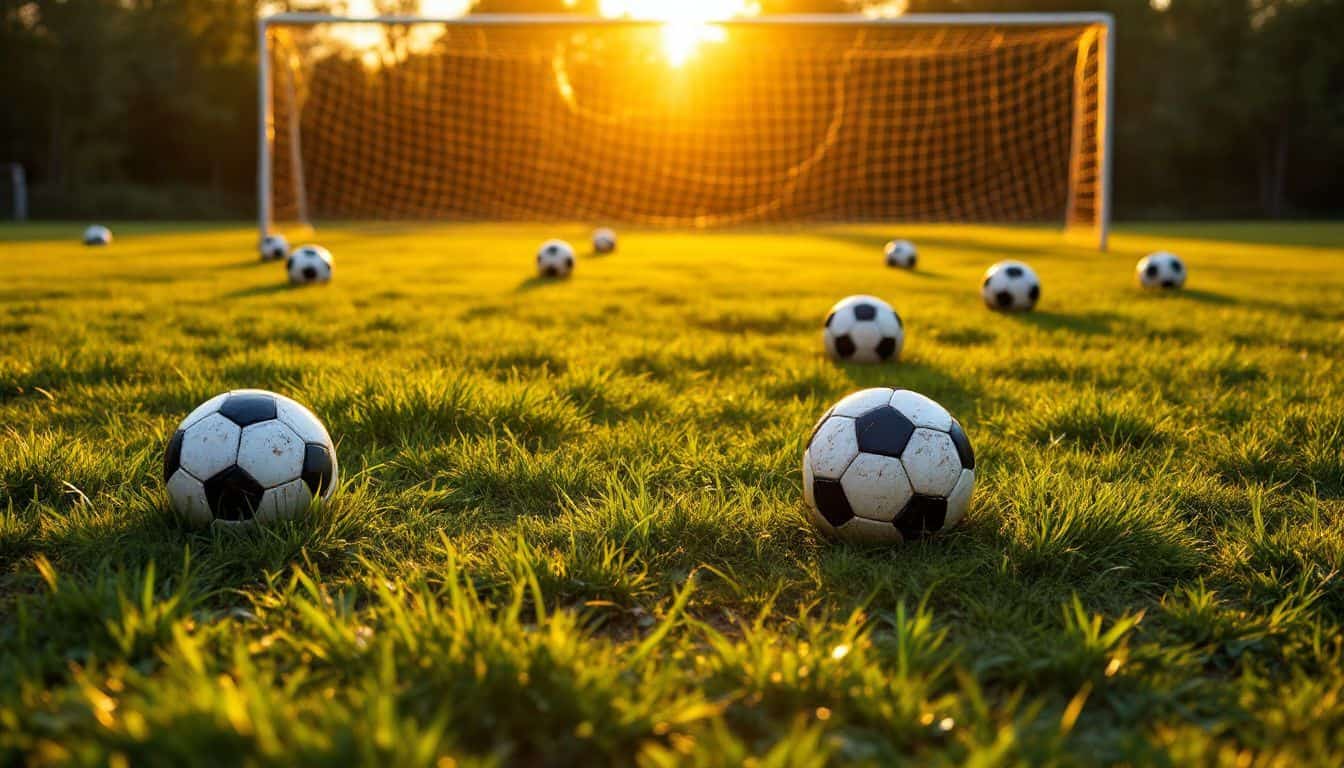
Joining local soccer clubs can boost your skills fast. You’ll meet new friends and learn from coaches. Want to know more about improving your game? Keep reading!
Join soccer clubs and leagues
Soccer clubs and leagues offer a great way to improve your skills and make new friends. Let’s explore some tips for joining these groups.
- Find local clubs: Look for soccer clubs in your area. The Wisconsin U14 Girls and Palm Beach U16 are examples of youth clubs you might find.
- Check club reputation: Research the club’s track record. Hawaii Rush Soccer Club, for instance, is known for its player-first approach and elite coaching.
- Consider club achievements: Look for clubs with a history of success. Some clubs, like Hawaii Rush, have earned titles such as 2023 National Champions.
- Attend tryouts: Most clubs hold tryouts to assess new players. Show up ready to showcase your dribbling, passing, and shooting skills.
- Start with recreational leagues: If you’re new to soccer, begin with a casual league to build confidence and learn the basics.
- Ask about training programs: Inquire about the club’s practice schedule and training methods. Good clubs offer regular drills to enhance your skills.
- Get proper gear: Invest in quality cleats, shin guards, and a ball. These tools are crucial for practice and games.
- Learn the rules: Familiarize yourself with soccer rules, including offside positions, throw-ins, and corner kicks.
- Be open to different positions: Try playing various roles on the field. You might discover you’re great at being a right back or a striker.
- Stay committed: Regular attendance at practices and games is key. It helps you improve and shows your dedication to the team.
- Make friends: Soccer is a team sport. Building good relationships with your teammates can make the experience more enjoyable and improve your watching sports together off the field.
Attend soccer camps and clinics
Soccer camps and clinics offer a great way to boost your skills. They’re perfect for women who want to up their game.
Here’s why you should attend:
- Expert coaching: You’ll learn from pros who know the ins and outs of soccer. They’ll teach you about free kicks, yellow cards, and more.
- Skill focus: Camps zero in on key areas like dribbling, passing, and shooting. You’ll practice these moves until they feel natural.
- Fitness boost: Running drills and playing matches will get your heart pumping. It’s a fun way to improve your health.
- Team play: You’ll learn how to work with others on the field. This helps with both soccer and life skills.
- New friends: Meet other women who love soccer as much as you do. You might find a new training buddy.
- Confidence builder: As you get better, you’ll feel more sure of yourself. This can help in all areas of life.
- Game knowledge: Learn about offsides, penalties, and other rules. Understanding these makes watching pro games more fun.
- Position training: Find out which spot on the field suits you best. You might discover you’re a natural goalkeeper or striker.
- Fun atmosphere: Camps mix learning with games and challenges. It’s way more exciting than solo practice.
- Quick improvement: A week at camp can do wonders for your play. You’ll see fast progress in your skills.
People Also Ask
What’s the best way to master the art of kicking off?
To nail the kickoff, practice your footwork. Start at the center of the field and aim for a teammate. Remember, a good kickoff can set the tone for the whole game. It’s not just about power, but precision too. Think of it as the opening act of your soccer show.
How can I improve my skills for both direct and indirect free kicks?
Free kicks are your chance to shine. For direct kicks, aim for the corners of the goal. Indirect kicks need teamwork. Practice with friends to create clever plays. Imagine you’re painting a masterpiece with your feet. The goalposts are your canvas, and the ball is your brush.
What should I know about the penalty area and penalty kicks?
The penalty area is like a danger zone. If you foul there, it’s penalty kick time. When taking a penalty, keep your cool. Pick a spot and stick to it. It’s just you, the ball, and the keeper. No pressure, right? Just kidding – there’s tons of pressure. But that’s what makes it fun!
How do substitutions and the bench work in soccer?
The bench isn’t just for sitting pretty. It’s where the game can change. Coaches use subs to shake things up. If you’re on the bench, stay ready. Your moment could come any time. It’s like being a superhero waiting to save the day.
What’s the deal with red cards and sending offs?
Red cards are soccer’s ultimate “time out.” Get one, and you’re hitting the showers early. They’re given for serious fouls or unsportsmanlike behavior. Two yellow cards equal a red. So, play nice and stay on the field. It’s no fun watching from the sidelines.
How do formations and tactics affect the game?
Formations are like chess moves on a soccer field. They change how your team attacks and defends. Learn different setups like 4-4-2 or 3-5-2. Good formations can make your team click. Bad ones can leave you exposed. It’s all about finding the right fit for your squad.
References
https://www.soccer.com/guide/how-to-play-soccer-guide-for-beginners (2022-11-14)
https://www.soccer.com/guide/rules-of-soccer-guide (2022-11-14)
https://skillshark.com/soccer-dribbling/
https://www.ncbi.nlm.nih.gov/pmc/articles/PMC10690516/
https://soccerstars.com/soccer-fundamentals/
https://www.veo.co/en-us/article/improve-your-soccer-skills
https://www.cupello.com/blog/training-soccer
https://www.playerdata.com/blog/how-to-get-better-at-soccer (2024-08-13)
https://www.ncbi.nlm.nih.gov/pmc/articles/PMC9331326/
https://www.developingthefuture.club/post/2016/08/07/player-development-through-gaming
https://www.amazon.com/Soccer-Positions-Step-Step-Understand/dp/1949511138
https://www.amazon.com/Soccer-Strategies-Defensive-Attacking-Tactics/dp/189094632X
https://www.onlinesocceracademy.com/
https://skillshark.com/soccer-training-apps/
https://anytime-soccer.com/7-best-soccer-coaching-apps/
https://www.hawaiirush.soccer/
https://soccerstars.com/the-complete-guide-for-soccer-clinics-in-2024/
